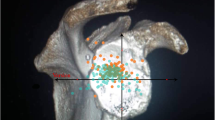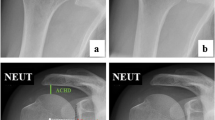Abstract
Introduction
The number of patients above 40 years suffering an anterior shoulder dislocation for the first time has recently increased. This study investigated the role of glenoid version, inclination and rotator interval dimension in patients older than 40 years with an anterior shoulder dislocation. We hypothesize that the rotator interval plays a more important role than the osseus alignment in older patients.
Materials and methods
Patients aged older than 40 years with a traumatic shoulder dislocation were compared with patients who had undergone magnetic resonance imaging (MRI) for a different reason. The MRIs of 61 dislocation group patients were compared with MRIs of 73 comparison group patients. Two shoulder surgeons measured glenoid version, inclination, height and width, rotator interval (RI) height, base (width) and area. The study and comparison group consisted of 61 patients with a mean age of 59 ± 9 years and 73 patients with a mean age of 57 ± 12, respectively.
Results
The mean glenoid version of the dislocation group was − 4.9° ± 4.4° (retroversion) and mean inclination was 9.8° ± 8° (reclination). Mean rotator interval base, height and the rotator interval area was 46 ± 6 mm, 14 ± 5 mm and 33 ± 14 mm2, respectively. The comparison group had a mean glenoid version of − 5.4° ± 5.4° and a mean inclination of 10.8° ± 6.2°. The rotator interval base was 41 ± 6 mm, the height was 16 ± 4 mm and the area was 34 ± 11 mm2. The between-group differences were statistically significant for rotator interval height and base (p < 0.0001). A significant difference was revealed for the height–width ratio of the glenoid (p = 0.0001).
Conclusions
In patients older than 40 years who have suffered anterior shoulder dislocation, the shape of the glenoid rather than its spatial position is of significance. A wide and high rotator interval promotes anterior shoulder dislocation in these patients.




Similar content being viewed by others
References
Bartko JJ (1966) The intraclass correlation coefficient as a measure of reliability. Psychol Rep 19:3–11. https://doi.org/10.2466/pr0.1966.19.1.3. Accessed 16 Feb 2018
Brophy RH, Marx RG (2009) The treatment of traumatic anterior instability of the shoulder: nonoperative and surgical treatment. Arthrosc J Arthrosc Relat Surg 25:298–304. http://linkinghub.elsevier.com/retrieve/pii/S0749806308009432. Accessed 27 Feb 2017
Dodson CC, Cordasco FA (2008) Anterior glenohumeral joint dislocations. Orthop Clin N Am 39:507–518. http://linkinghub.elsevier.com/retrieve/pii/S0030589808000461. Accessed 6 Mar 2017
Eichinger JK, Massimini DF, Kim J, Higgins LD (2016) Biomechanical evaluation of glenoid version and dislocation direction on the influence of anterior shoulder instability and development of Hill-Sachs lesions. Am J Sports Med 44:2792–2799. http://www.ncbi.nlm.nih.gov/pubmed/27496904. Accessed 21 Aug 2018
Frank RM, Taylor D, Verma NN, Romeo AA, Mologne TS, Provencher MT (2015) The rotator interval of the shoulder. Orthop J Sport Med 3:232596711562149. http://www.ncbi.nlm.nih.gov/pubmed/26779554. Accessed 8 Feb 2018
Gomberawalla MM, Sekiya JK, Sekiya JK (2014) Rotator cuff tear and glenohumeral instability. Clin Orthop Relat Res 472:2448–2456. http://www.ncbi.nlm.nih.gov/pubmed/24043432. Accessed 21 Aug 2018
Gumina S, Postacchini F (1997) Anterior dislocation of the shoulder in elderly patients. J Bone Jt Surg Br 79:540–3. http://www.ncbi.nlm.nih.gov/pubmed/9250734. Accessed 2 May 2016
Harryman DT, Sidles JA, Harris SL, Matsen FA (1992) The role of the rotator interval capsule in passive motion and stability of the shoulder. J Bone Jt Surg Am 74:53–66. http://www.ncbi.nlm.nih.gov/pubmed/1734014. Accessed 8 Feb 2018
Hohmann E, Tetsworth K (2015) Glenoid version and inclination are risk factors for anterior shoulder dislocation. J Shoulder Elb Surg 24:1268–1273. http://www.ncbi.nlm.nih.gov/pubmed/25958217. Accessed 8 Dec 2016
Hovelius L, Rahme H (2016) Primary anterior dislocation of the shoulder: long-term prognosis at the age of 40 years or younger. Knee Surg Sports Traumatol Arthrosc 24:330–42. http://www.ncbi.nlm.nih.gov/pubmed/26754859. Accessed 7 Apr 2016
Hsu HC, Luo ZP, Cofield RH, An KN. Influence of rotator cuff tearing on glenohumeral stability. J Shoulder Elb Surg 6:413–22. http://www.ncbi.nlm.nih.gov/pubmed/9356929. Accessed 21 Aug 2018
Hunt SA, Kwon YW, Zuckerman JD (2007) The rotator interval: anatomy, pathology, and strategies for treatment. J Am Acad Orthop Surg 15:218–27. http://www.ncbi.nlm.nih.gov/pubmed/17426293. Accessed 8 Feb 2018
Itoi E, Berglund LJ, Grabowski JJ, Naggar L, Morrey BF, An K-N (1998) Superior-inferior stability of the shoulder: role of the coracohumeral ligament and the rotator interval capsule. Mayo Clin Proc 73:508–515. http://www.ncbi.nlm.nih.gov/pubmed/9621856. Accessed 8 Feb 2018
Kim K-C, Rhee K-J, Shin H-D, Kim Y-M (2007) Estimating the dimensions of the rotator interval with use of magnetic resonance arthrography. J Bone Jt Surg 89:2450. http://www.ncbi.nlm.nih.gov/pubmed/17974888. Accessed 27 Feb 2017
Labriola JE, Lee TQ, Debski RE, McMahon PJ (2005) Stability and instability of the glenohumeral joint: the role of shoulder muscles. J Shoulder Elb Surg 14:32S–38S. http://www.ncbi.nlm.nih.gov/pubmed/15726085. Accessed 27 Feb 2017
Lee JC, Guy S, Connell D, Saifuddin A, Lambert S (2007) MRI of the rotator interval of the shoulder. Clin Radiol 62:416–423. http://www.ncbi.nlm.nih.gov/pubmed/17398265. Accessed 8 Feb 2018
Lenart BA, Freedman R, Van Thiel GS, Dhawan A, McGill KC, Basu S, Meyer JR, Provencher CMT, Cole BJ, Romeo AA, Verma NN (2014) Magnetic resonance imaging evaluation of normal glenoid length and width: an anatomic study. Arthrosc J Arthrosc Relat Surg 30:915–920. http://www.ncbi.nlm.nih.gov/pubmed/24813321 Accessed 16 Feb 2018
Leroux T, Wasserstein D, Veillette C, Khoshbin A, Henry P, Chahal J, Austin P, Mahomed N, Ogilvie-Harris D (2014) Epidemiology of primary anterior shoulder dislocation requiring closed reduction in Ontario, Canada. Am J Sports Med 42:442–50. http://www.ncbi.nlm.nih.gov/pubmed/24275862. Accessed 29 July 2018
Maurer A, Fucentese SF, Pfirrmann CWA, Wirth SH, Djahangiri A, Jost B, Gerber C (2012) Assessment of glenoid inclination on routine clinical radiographs and computed tomography examinations of the shoulder. J Shoulder Elb Surg 21:1096–1103. http://www.ncbi.nlm.nih.gov/pubmed/22036540. Accessed 6 Mar 2017
Murthi AM, Ramirez MA (2012) Shoulder dislocation in the older patient. J Am Acad Orthop Surg. 20:615–622. http://www.ncbi.nlm.nih.gov/pubmed/23027691. Accessed 27 Feb 2017
Owens BD, Campbell SE, Cameron KL (2014) Risk factors for anterior glenohumeral instability. Am J Sports Med 42:2591–2596. https://doi.org/10.1177/0363546514551149. Accessed 27 Feb 2017
Petchprapa CN, Beltran LS, Jazrawi LM, Kwon YW, Babb JS, Recht MP (2010) The rotator interval: a review of anatomy, function, and normal and abnormal MRI appearance. Am J Roentgenol 195:567–576. https://doi.org/10.2214/AJR.10.4406. Accessed 27 Feb 2017
Pradhan RL, Itoi E (2001) Rotator interval lesions of the shoulder joint. Orthopedics 24:798–801. http://www.ncbi.nlm.nih.gov/pubmed/11518414. Accessed 8 Feb 2018 (quiz 802–3)
Rhee YG, Cho NS, Cho SH (2009) Traumatic anterior dislocation of the shoulder: factors affecting the progress of the traumatic anterior dislocation. Clin Orthop Surg 1:188. https://synapse.koreamed.org/DOIx.php?id=10.4055/cios.2009.1.4.188. Accessed 27 Feb 2017
Shin S-J, Yun Y-H, Kim DJ, Yoo JD (2012) Treatment of traumatic anterior shoulder dislocation in patients older than 60 years. Am J Sports Med 40:822–7. http://www.ncbi.nlm.nih.gov/pubmed/22287643. Accessed 2 May 2016
Tétreault P, Krueger A, Zurakowski D, Gerber C (2004) Glenoid version and rotator cuff tears. J Orthop Res 22:202–207. https://doi.org/10.1016/S0736-0266%2803%2900116-5 Accessed 6 Mar 2017
Teunis T, Lubberts B, Reilly BT, Ring D (2014) A systematic review and pooled analysis of the prevalence of rotator cuff disease with increasing age. J. Shoulder Elb Surg 23:1913–1921. http://www.ncbi.nlm.nih.gov/pubmed/25441568. Accessed 6 Mar 2017
Toolanen G, Hildingsson C, Hedlund T, Knibestöl M, Oberg L (1993) Early complications after anterior dislocation of the shoulder in patients over 40 years. An ultrasonographic and electromyographic study. Acta Orthop Scand 64:549–52. http://www.ncbi.nlm.nih.gov/pubmed/8237322. Accessed 8 Feb 2018
Woertler K (2015) Rotator interval. Semin Musculoskelet Radiol 19:243–253. http://www.thieme-connect.de/DOI/DOI?10.1055/s-0035-1549318. Accessed 27 Feb 2017
Zacchilli MA, Owens BD (2010) Epidemiology of shoulder dislocations presenting to Emergency Departments in the United States. J Bone Jt Surg Am 92:542–549. http://www.ncbi.nlm.nih.gov/pubmed/20194311. Accessed 29 July 2018
Funding
There is no funding source.
Author information
Authors and Affiliations
Corresponding author
Ethics declarations
Conflict of interest
The authors declare that they have no conflict of interest.
Human and animal rights
This article does not contain any studies with human participants or animals performed by any of the authors.
Rights and permissions
About this article
Cite this article
Thiesen, D.M., Ernst, M., Meyer, J. et al. Glenoid and rotator interval dimension in patients older than 40 years after traumatic anterior shoulder dislocation. Arch Orthop Trauma Surg 139, 181–187 (2019). https://doi.org/10.1007/s00402-018-3054-2
Received:
Published:
Issue Date:
DOI: https://doi.org/10.1007/s00402-018-3054-2




